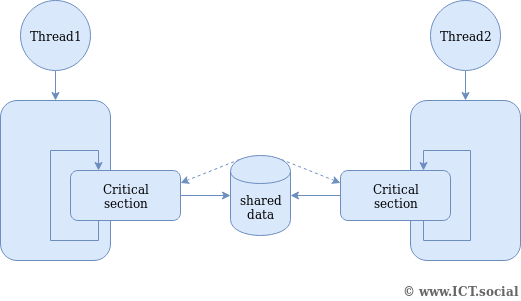Lesson 6 - Multithreading in Java - Semaphore
In the previous lesson, Multithreading in Java - Useful components for parallelism, we summarized other available techniques for parallel programming. Today, we're going to show the first of the advanced classes for parallel programming - the semaphore.
Critical Section
Before describing individual synchronization primitives, we'll explain what exactly a critical section is. In the previous lessons, we mentioned it briefly, but didn't explain it in detail. Let's fix that.
A critical section is where concurrency occurs, i.e. where common data is being accessed.

Our goal is to ensure that only one process/thread works with the critical section at a time.
Each critical section refers to specific data being accessed in
it (x, y, z, s1, ...). We
try to not lock everything but only specific critical
places where the data is shared.
We've already introduced one synchronization primitive: monitor.
Monitor support must be implemented directly in the programming language. In
Java, the monitor is implemented using the synchronized keyword.
Now let's move on to other primitives.
The Semaphore in C
To understand the principles of the semaphore, we'll show a short abstract implementation in the C language. Dijkstra (1962/1963) designed a primitive that simplifies
...End of the preview...
Continue further
You've come here and that's great! We believe that the first lessons showed you something new and useful
Do you want to continue the course? Go to the premium section.
Buy this course
This article is licensed: Premium, by buying this article, you agree with the terms of use.
- Unlimited and permanent access to individual lessons.
- High quality IT knowledge.
- Skills to help you get your dream and well-paid job.
Article description
Requested article covers this content:
In this tutorial, we'll introduce advanced techniques for parallel programming in Java. We'll describe the semaphore.
You gain credits by supporting our network. This is done by sending a helpful amount of money to support the site, or by creating content for the network.

